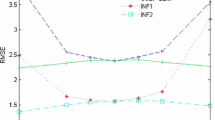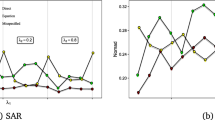Abstract
A small number of time-series observations relative to regions precludes estimation of the entire structure of regional dependence in a pooled regression model. The resulting need for parsimonious models of regional dependence can be satisfied through the use of spatial autocorrelation structures. This article explores an alternative methodology that allows the researcher to estimate disturbance covariances for regions that are closely linked, even when the number of time-series observations is relatively low. The approach presented here shares the advantage of spatial autocorrelation structures in being parsimonious, but offers the additional advantage of relying more completely on sample information to provide estimates of dependence between regions within specified regional groups. Monte Carlo experiments suggest that block-covariance models offer substantial efficiency gains over simple heteroskedastic models. The experiments also suggest that when the number of time-series observations is limited and the correlations of disturbances between regions are small, block structures yield efficiency gains over a full-information model.
Similar content being viewed by others
References
Anselin L (1980) Estimation methods for spatial autoregressive structures. Ithaca, NY: Regional Science Dissertation and Monograph Series No. 8, Cornell University
Anselin L (1986) Non-nested tests on the weight structure in spatial autoregressive models: some Monte Carlo results. J Reg Sci 26:267–284
Anselin L (1988) Model validation in spatial econometrics: a review and evaluation of alternative approaches. Int Reg Sci Rev 11:279–316
Anselin L (1990) Some robust approaches to testing and estimation in spatial econometrics. Reg Sci Urban Econ 200:141–163
Arora S, Brown M (1977) Alternative approaches to spatial autocorrelation: an improvement over current practice. Int Reg Sci Rev 2:67–78
Blommestein H, Nijkamp P (1986) Testing the spatial scale and the dynamic structure in regional models. A contribution to spatial econometric specification analysis. J Reg Sci 26:1–17
Breusch TS (1980) Useful invariance results for generalized regression models. J Econ 13:327–340
Cliff AD, Ord JK (1973) Spatial autocorrelation. London, Pion
Fisher WD (1971) Econometric estimation with spatial dependence. Reg Urban Econ 1:19–40
Fomby TB, Hill RC, Johnson SR (1984) Advanced econometric methods. Berlin Heidelberg New York, Springer
Hordijk L, Nijkamp P (1977) Dynamic models of spatial autocorrelation. Environ Plan 5:505–519
Hordijk L, Nijkamp P (1978) Estimation of spatio-temporal models: new directions via distributed lags and Markov schemes. In: Karlquist A, Lundqvist L, Snickars F, Weibull LW (eds) Spatial interaction theory and planning models. Amsterdam, North Holland
Kmenta J, Gilbert RF (1968) Small sample properties of alternative estimators of seemingly unrelated regressions. J Am Stat Assoc 65:186–197
Mehta JS, Swamy PAVB (1976) Further evidence on the relative efficiencies of Zellner's seemingly unrelated regressions estimator. J Am Stat Assoc 71:634–639
Parks RW (1967) Efficient estimation of a system of regression equations when disturbances are both serially and contemporaneously correlated. J Am Stat Assoc 62:500–509
Theil H (1971) Principles of econometrics, New York, Wiley
White EN, Hewings GJD (1982) Space-time employment modeling: some results using seemingly unrelated regression estimators. J Reg Sci 22:283–302
Zellner A (1962) An efficient method of estimating seemingly unrelated regressions and tests for aggregation bias. J Am Stat Assoc 57:348–368
Author information
Authors and Affiliations
Additional information
We thank Thomas Fomby, Esfandiar Maasoumi, and the referees for helpful comments. The views expressed are those of the authors and do not necessarily reflect official views of the Federal Reserve System.
Rights and permissions
About this article
Cite this article
Gunther, J.W., Schmidt, R.H. Increasing the efficiency of pooled estimation with a block-diagonal covariance structure. Ann Reg Sci 27, 133–142 (1993). https://doi.org/10.1007/BF01581941
Received:
Accepted:
Issue Date:
DOI: https://doi.org/10.1007/BF01581941




